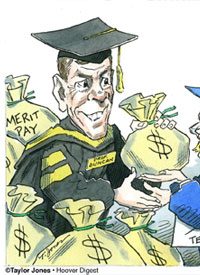
ITEM: An MCT News Service article in the Chicago Tribune for November 4 reported: “During a speech … in Madison, Wis., [President] Obama plugged the federal government’s $4.35 billion Race to the Top program, which will soon allot extra federal stimulus funds to states based on the strength of the education reforms those states enact.”
Quoting the President, the report continued: “‘We’re putting over $4 billion on the table, four billion with a “B,” one of the largest investments that the federal government has ever made in education reform,’ he said. ‘But we’re not just handing it out to states because they want it. We’re not just handing it out based on population. It’s not just going through the usual political formulas. We’re challenging states to compete for it.’”
ITEM: In a December 4 editorial, headlined “Michigan lawmakers must adopt reforms to liberate schools,” the Detroit News commented: “Michigan’s application for President Barack Obama’s Race to the Top competition for education grants is due, and the state is one of just two in the nation that is unprepared to apply. What’s at risk: at least $500 million for public schools desperate for cash. Brutal budget cuts are projected for almost every district in the state — and this competitive federal stimulus money would help buffer the impact on education. The Race to the Top competition was designed to spur states to undertake overdue education reforms that will make the U.S. an economic and education leader once again. The basic requirements are that states hold educators accountable for the performance of students and provide alternatives to failing schools and teachers….
“The push to beef up education attainment has been stalled, in large part, by the state’s strongest teacher union, the Michigan Education Association (MEA), which has cowed timid lawmakers.”
ITEM: An opinion piece in the Wall Street Journal for November 24 was written by Harold E. Ford, Jr., chairman of the Democratic National Leadership Council; Louis Gerstner, Jr., former chairman of IBM and former chairman of the Teaching Commission; and Eli Broad, founder of the Broad Foundations. They wrote: “Competition among the states is also vital to reform. The administration is resisting the temptation to award funds to as many states as possible. And that’s good. To be effective, Race to the Top funds cannot become a democratic handout. Competition brings out the best performance. That’s true in athletics and in business, and it’s true in education.”
CORRECTION: A lot of lip service gets paid to the value of competition in education, coming from those with both liberal and conservative reputations. Most of it is double-talk and empty rhetoric.
Unmentioned of course is that education is not the proper responsibility of the federal government. Under the Constitution, there is no authority for the Congress to fund or operate schools, or for lawmakers to set up an educational bureaucracy to regulate educational standards, curriculum, and policies of school systems. This was long and rightly handled at the state and local levels of government. States could really compete if they ran and funded their own programs — or, better still, many champions of liberty believe, they could phase out involvement in education and allow private education to flourish. Indeed, overall results have fallen the deeper the feds have gotten into education and our pockets.
However, the Department of Education — whose very existence represented a political payoff by President Jimmy Carter to the National Education Association — pays little heed to such matters as the Constitution. Most legislators also consider paying attention to such matters to be quaint and outmoded.
There’s also a tendency among many of those with a conservative bent to think that anything opposed by teachers’ unions must be worthy of their support. Not necessarily. Just because some union leaders don’t want their members to be held accountable doesn’t mean that swallowing the federal government’s latest big-spending panacea is an apt remedy. Chucking more federal taxes at state education monopolies because they fill out the proper forms and jump through certain bureaucratic hoops is not a formula for success. Yet state officials prefer to pretend that this is “free” money and disregard the fact that federal monies always have strings attached.
The Race to the Top program is yet another federal scheme to bribe taxpayers with their own money. Unfortunately, state governments eager to receive handouts from Washington prefer to beg at the federal table for scraps rather than try to raise necessary monies directly. Nevertheless, the United States will not achieve educational excellence by having Washington spend more money. If merely shoveling out dollars did the job, the country would be well-nigh full of geniuses — considering that the federal government has splurged almost $2 trillion on federal education programs since 1965.
And there are still those who claim there is not enough being spent on public schooling. This is simply untrue. Consider the most recent federal data available, employing inflation-adjusted, per-pupil spending, public-school expenditures almost doubled between the 1975-1976 and 2005-2006 school years. Was this just because there were more pupils? Nope. In 1990, there were 9.2 students per public-school employee. By 2006, that number had dropped to 8 students per employee. Not surprisingly, having more “education” employees didn’t translate into a comparable increase in achievement.
Washington has already squandered $100 billion or so on “education” in President Obama’s so-called stimulus package, but that just whet the appetite of the establishment that wants to set standards and curricula for every school in the nation. The bureaucratic track record strongly suggests that more of its top-down national standards will come to a bad end. As pointed out by the Wall Street Journal, “Between 1970 and 2004, per-pupil outlays more than doubled in real terms, and the federal portion of that spending nearly tripled. Yet reading scores on national standardized tests have remained relatively flat.”
To be sure, real competition frequently does bring out the best. But Michael Phelps did not win his gold medals because a Department of Swimming concocted a Race to the End of the Pool program.
Writing in the New York Daily News, Andrew Coulson observed that, “Cell phone makers have not relentlessly improved their products because of national mandates. They’ve done it to attract customers away from their competitors. Amazon did not diversify its business and create the Kindle because a consortium of Internet vendors demanded it, but because Amazon sought to beat its competition.” The author of the study “Comparing Public, Private, and Market Schools,” Coulson continued:
At the dawn of the 21st century, three quarters of American children are still assigned to schools based on where they live, by bureaucrats who have never met them. Stellar public schools cannot grow and take over less successful ones. Ineffective public schools have little fear of losing students to competitors because they have no real competitors — they enjoy a monopoly on $12,000 per pupil in public spending.
I published a paper in the Journal of School Choice collecting every scientific study I could find comparing public and private school outcomes. These scores of findings span the globe and cover everything from academic achievement and cost-effectiveness to parental satisfaction. And they favor competitive market school systems over state-run monopolies by a margin of 15 to 1.
The competition said to be so beloved (see above) by Messrs. Ford, Broad, and Gerstner attracted the attention of Neal McCluskey, who recalled, for example, a previous Wall Street Journal piece by Gerstner. In that December 2008 article, McCluskey observed, Gerstner “declared that the nation should have just 70 school districts (versus about 15,000 today and 130,000 in the late 1920s), national academic standards and tests, and a longer school year. In other words, exactly the kind of centralization that has proven a total disaster for decades … only on steroids!”
McCluskey, who is associate director of the Cato Institute’s Center for Educational Freedom, is no fan of Race to the Top, for good reason. As he noted of this supposed incentive, “The money is a one-shot deal — once paper promises are accepted and the money delivered, it’s over.” He went on:
Mostly this plan, while not requiring any real reform, pushes an unprecedented centralization of education power. It calls for state data systems to track students from pre-kindergarten to college graduation. It calls for states to sign onto “common” — meaning federal — standards. It tries to dictate state budgets. In other words, it does exactly what’s been wrong with American education for decades: centralize power in the hands of ever more distant, unaccountable bureaucrats rather than leaving it with the communities, and especially parents, the schools are supposed to serve.
There is little that is new about this “race” being pushed by the Department of Education and White House except the number of tax dollars that will be scattered from Washington. The spendthrift politicians and all-too-amenable federal bureaucrats are just trying to keep the greenbacks flowing effortlessly into the pockets of their allies while they disguise the truth: True education is not received, it is achieved.




